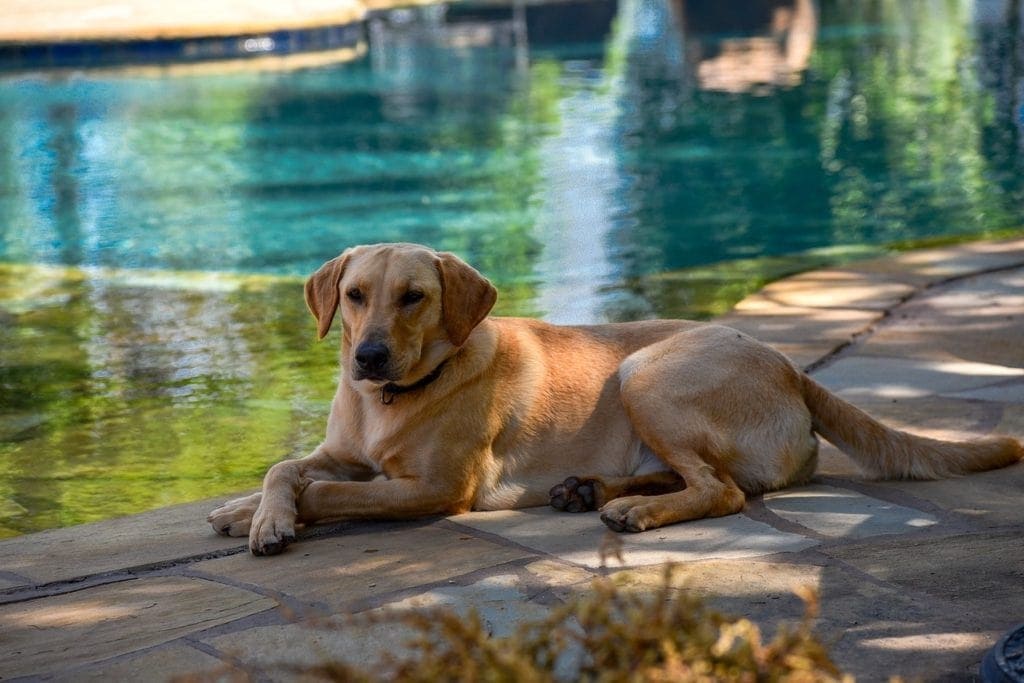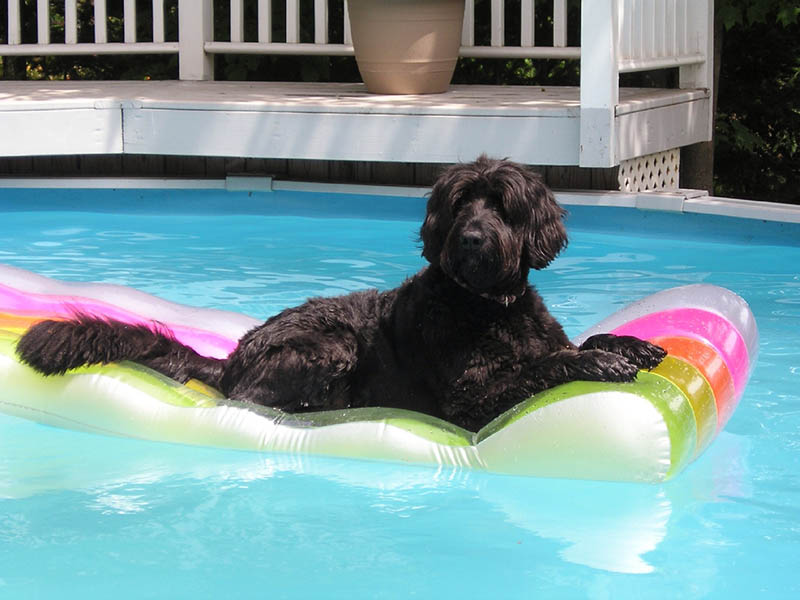Swimming pools are fun and refreshing, but they can pose a risk to humans and pets. Whether it’s an in-grown pool or an above-ground model, you must prevent your dog from having free access to it. Knowing how to stay safe will ensure that everyone has a good time. Even if your dog hates everything to do with water and stays well away from the pool, it’s still a good idea to keep the following tips in mind.

The 9 Tips for Pool Safety for Dogs
1. Restrict Access to the Pool
Limiting your dog’s access to the backyard pool can go a long way toward helping them stay safe. If you have a sturdy fence and a lockable gate surrounding the pool, your dog is less likely to accidentally fall in when playing fetch or during a bout of the zoomies.
A durable fence won’t just protect your dog, either. It can also keep children and adults from plummeting into the water when playing games outside. If you can’t afford to build a wooden or chain-link fence, try a reliable temporary measure like a heavy-duty safety fence instead.
It might not be aesthetically pleasing, but it’ll keep your dog away from the water when you’re away from the house.
2. Supervise Your Dog
Looking after dogs is like looking after children. You need to supervise them whenever they’re in a potentially dangerous situation. It’s tempting to stretch out on a sunbed and nap the afternoon away, lose yourself in your favorite album, or watch a movie on your phone whenever you’re by the pool. However, if your dog is with you, you must remove your headphones and pay attention.
Even if your dog is an adept swimmer, they might not realize they’re tired from all the activity. You might need to end the pool playtime before they get into trouble. If you’re busy working, sending your dog outside alone is tempting if you have a secure yard. Unless you have a pool fence, you should spare a few moments to ensure your dog doesn’t stray too close to the pool, just in case.

3. Get Swimming Lessons
Swimming lessons might seem unnecessary, but not all dogs are natural swimmers. Many breeds aren’t naturally drawn to water and find it difficult to swim due to their body shape or the length of their legs. While dogs developed for water retrieval, like the Labrador Retriever, might love splashing around in the pool, breeds like the Dachshund might not.
Taking the time to teach your puppy how to swim is a lifesaver regarding pool safety. Not only does it ensure that your dog knows how to move in water, even if they’re not a fan of it, but it also informs you of their capabilities and how much assistance they’ll need if they ever fall in.

4. Invest in a Doggy Life Jacket
A canine life jacket can save your dog’s life. If your dog is an adept swimmer, they likely won’t need a life vest unless it’s their first time around water. However, dogs that have more trouble in the water should always wear a life vest near deep water, even in a backyard pool.
A life vest designed for dogs also provides a way to grab your dog if they need assistance. Most life vests have sturdy handles that you can use to support your dog.
5. Use a Pool Alarm
Although a pool alarm won’t keep your dog away from the pool, it will alert you if there’s a disturbance other than the normal movement of the water. If your dog falls in while you’re still in the house, you’ll be alerted to the situation and be able to see if your dog is okay.
Remember that a pool alarm should never replace proper supervision or a pool fence. It’s intended to alert you to a problem so you can act as soon as possible rather than be the only means of keeping your dog safe.

6. Follow Pool Rules
When it comes to pool safety for everyone, not just your dog, a set of pool rules can make the difference between a fun day out or an emergency trip to the hospital or vet.
Pool rules should include safety measures for you and your dog. Two common pool rules are no running by the pool and no diving. If your dog likes to hang around the pool, you should add a rule that everyone must remember to shut the gate if you have one or a reminder to always supervise your four-legged friend around the water.

7. Learn Canine CPR
Knowing basic first aid is one of the best ways to prepare for any eventuality, and your dog can benefit when you know how to treat their scrapes and bruises. Another essential first aid technique to know if you want to prepare for accidents is CPR.
If you have a pool in your backyard, the chances are that you already know CPR in case you ever need it for your human family members. Even if your dog doesn’t spend much time around the pool, learning canine CPR might save their life one day.
If you need urgent veterinary advice, consult a vet online.
If you need to speak with a vet but can’t get to one, head over to PangoVet. It’s an online service where you can talk to a vet online and get the personalized advice you need for your pet — all at an affordable price!

8. Provide Dog-Accessible Exit Routes
Swimming pools are relatively easy to exit, even if you don’t have a ladder. Dogs, however, aren’t physically capable of the same movement to lift themselves out of the water. Therefore, you must create a way for your dog to exit the water quickly.
If you don’t have a pool with built-in steps, setting up a ramp is a simple but effective solution. It might take up space in your pool, but it serves as a way for dogs to climb out of the water.
Once it’s installed, teach your dog where the ramp is so they always know how to get out of the water.

9. Know the Dangers of Pool Covers
A pool cover is a valuable way to save time cleaning debris out of your pool, but it can also be a recipe for disaster. While some pool covers are solid and can hold significant weight, most are simple mesh covers that won’t support you or your dog.
Mesh covers are among the most common reasons many dogs drown in backyard pools. If your dog falls in when you’re out of the house, the pool cover can make it impossible for them to climb out again.
Unless you have a solid pool cover that your dog won’t fall through, never leave the pool covered if your dog has a chance of falling in. Either invest in a fence to keep your dog away or spare a few minutes cleaning the water of debris before you swim.

How to Tell When Your Dog Is Tired
Spending a day with your dog splashing around in the pool is always fun. In summer, it’s also the perfect way to cool off. However, there comes a time when the fun and games should be set aside to give your dog a break from swimming. While you know when you’re getting too fatigued to stay in the water, your dog, especially if they love swimming, is more likely to swim until they simply can’t anymore.
Part of your responsibility as a dog owner is recognizing when your dog is getting tired. This is another reason that supervision is so important. Paying close attention to your dog when they’re in the water will make you much more likely to notice when they’re fatigued.
Notice how your dog is swimming. Skilled swimmers can often swim around without getting their backs wet at all. When a dog gets tired, their rear end will start to sink into the water. This is a sign to call it quits for the day.
What’s the Best Way to Keep Your Dog Safe Around the Pool?
Although it might be easier to choose the best tip from the ones listed and only rely on it to keep your dog safe, a single precaution is not always the best solution. These tips work best when they’re used to keep your dog safe.
For example, if your dog loves water so much that they’ll break through the pool fence to go for a swim, a pool alarm will give you an alert.
You may also be interested in:

Summing Up
Keeping your dog safe around the pool might sound like a great deal of work, but taking extra precautions is essential. Drowning accidents are more common than you think, and they can occur even if your dog prefers to stay away from water. Following these tips will keep your dog safe and allow them to enjoy the pool as much as the rest of your family.
See also:
- How to Keep Dogs Safe Around Water: 15 Essential Tips
- How to Keep Your Dogs Safe from Wolf Attacks: Guide
Featured Image Credit: Jumpstory
Contents
- The 9 Tips for Pool Safety for Dogs
- 1. Restrict Access to the Pool
- 2. Supervise Your Dog
- 3. Get Swimming Lessons
- 4. Invest in a Doggy Life Jacket
- 5. Use a Pool Alarm
- 6. Follow Pool Rules
- 7. Learn Canine CPR
- 8. Provide Dog-Accessible Exit Routes
- 9. Know the Dangers of Pool Covers
- How to Tell When Your Dog Is Tired
- What’s the Best Way to Keep Your Dog Safe Around the Pool?
- Summing Up













